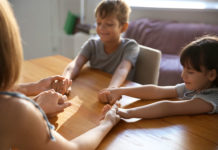KID-FRIENDLY FURNITURE AND EQUIPMENT
When I was a new children’s ministries director, I held meetings in the children’s classrooms, and the teachers sat in the preschoolers’ chairs. One day, a teacher brought in her own chair. I realized I had inadvertently placed this teacher in an awkward position. She had been distracted for entire meetings by her discomfort. She finally decided to bring her own chair. I was somewhat embarrassed, but discovered an important principle: People are more comfortable in furniture that is suited to their size.
Children need furniture and equipment that encourages independence as well as comfort. We recently purchased very small tables and chairs for our 1-year-old classes. The toddlers freely move on and off the chairs and around the tables. They are delighted at their ability to move independently of the adults.
CHARACTERS AND COSTUMES
Children are drawn to bigger-than-life characters. These characters embody a child’s imaginative power. At our church, we have several different characters the children have come to love. One is our big “pussy cat” of a lion named Clayton—our theme character. Between services, he mingles with the children and adults, shaking hands and nodding enthusiastically.
You can enhance your environment by having your staff dress in costumes that fit your theme. (Toddlers and young preschoolers are more receptive to characters and costumes from a distance.) When a child approaches the classroom, his or her first impression is of a room filled with the possibility of fantasy and adventure.
CONCLUSION
Many children’s workers face challenging space issues. They must use their creativity to transform seemingly unusable space into rooms children will enjoy visiting.
A quality children’s environment begins with adults who trust and value each other. Once that relationship is nurtured, the creative juices can begin to flow, and then watch the kids—children’s ministries never looked this good.












